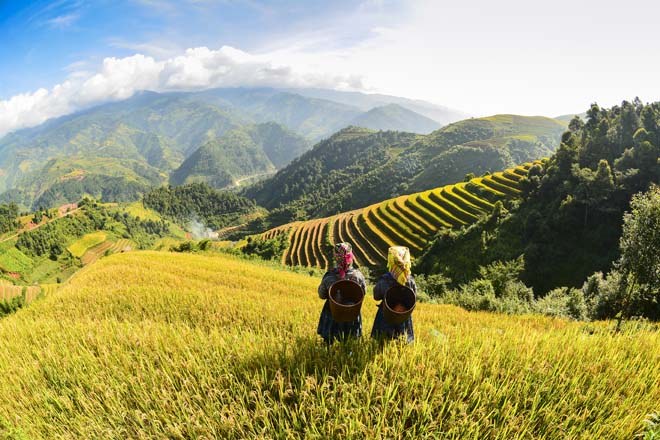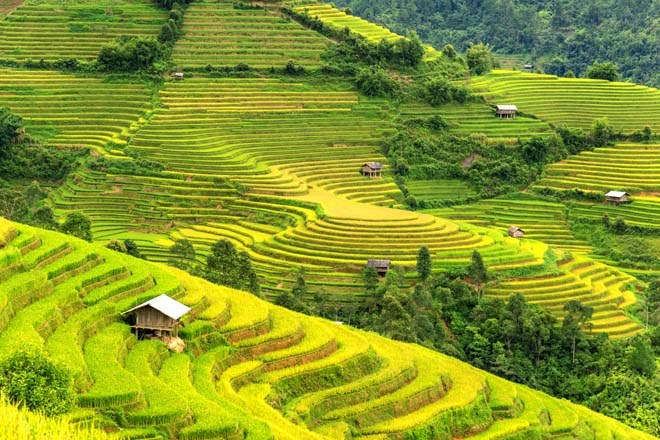Best time to visit the rice terraces of Sapa and Northern Vietnam
Considered to be one of the most photogenic sights in the world, the rice terraces around Sapa in Northern Vietnam have been attracting travellers and photographers for many years.
Considered to be one of the most photogenic sights in the world, the rice terraces around Sapa in Northern Vietnam have been attracting travellers and photographers for many years. The terraces are believed to have been carved out of the hillsides by the minority tribes of the area as long ago as the fifteenth century, and they are still cultivated today by the same local tribes in an annual cycle of planting, growth and harvesting. The terraces are punctuated by small wooden shelters and you will often see the locals, in their trademark conical hats, tending to their crops.
The Muong Hoa Valley, an easy walk from Sapa, has some of the most impressive terraces, with over 100 sinuous layers climbing steeply towards the sky. It's a must see sight for any visitor to the area.

Local tribespeople surveying their rice terraces
Not only is this region of Northern Vietnam visually stunning it’s also culturally fascinating. There are several ethnic minority groups living in Sapa and the more remote villages that are dotted in the surrounding hills. Giay, H’mong, Tay and Red Dzao are just some of the groups you may encounter if you get off-the-beaten-track and walk or trek in the mountains. They still live their rural lives in a very traditional way, little-changed by time. If you have the opportunity to spend a night in a local homestay it’s a great way to gain an insight into their way of life.
If you would like to visit Sapa, or trek to some of the tribal villages, here’s our guide to the best time to travel.
March – April
Although this is not a particularly good time to view the rice terraces as they have not yet been planted, wildflowers and blossoms are beginning to bloom in the surrounding fields and hillsides giving hints of colour. However as the village trails are dry, and there are less tourists visiting at this time of year, it’s a good time for trekking. Temperatures are generally mild and pleasant during the day (between 15 and 25 degrees), although nights can be still be pretty chilly given the higher mountain altitudes in this part of the country.
May – June
Known locally as the ‘water pouring’ season this is the start of the monsoon rains. The rains typically fall as heavy showers rather than persistent rainfall. The water pools in the rice terraces making for beautiful, mirror-like reflections. Rising mists also create beautiful scenes and atmospheric photos. This is the time of year when the terraces are planted with the young shoots so it’s a good time to see the locals working the fields using very traditional hand-farming methods. However, the rains make the trails boggy and difficult to navigate so it’s not advisable to go trekking or walking during these months.

Planting the rice terraces
July – August
This is peak monsoon season so it’s very wet and very hot and humid. Definitely not good for trekking! However, if you don’t mind braving the rains, and are happy to wait for the clouds to lift, you will be rewarded with classic views of vivid green rice terraces. Just beware, this is the main time for domestic tourists to visit Sapa so expect to be sharing your views with large crowds,
September –November
This is harvest season, but before the rice shoots are picked they turn a deep golden yellow in colour. Again, this makes for some fantastic photos. Heavy rains can still be experienced in September but October sees the start of the dry season. For trekkers, October and November are undoubtedly the best time to visit Sapa. The region is still lush and tropical after the monsoon, but the temperatures are starting to drop making them much more pleasant for walking.

Rice terraces turning to gold in September
December – February
Despite being a subtropical region, the higher mountain altitudes mean that the winter months can experience very cold weather - often falling below freezing at night. The rice terraces can also appear a little bleak at this time of the year so the region is best avoided during these winter months.
If you would prefer to visit Sapa at any other time of the year we can Tailor Make your perfect holiday. Simply complete our Tailor Made enquiry form or contact our friendly travel experts.
For more climate and destination information see our Vietnam holiday information